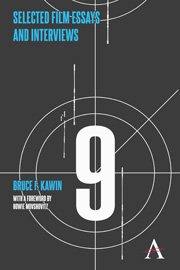Book contents
- Frontmatter
- Contents
- Foreword
- Preface
- PART I VIOLENCE AND POLITICS
- PART II HORROR AND SCIENCE FICTION
- PART III REVIEWS
- PART IV INTERVIEWS
- PART V LITERATURE AND NARRATION
- 14 The Montage Element in Faulkner's Fiction
- 15 Horton Foote
- 16 An Outline of Film Voices
- 17 Dorothy's Dream: Mindscreen in The Wizard of Oz
- PART VI GETTING IT RIGHT
- Acknowledgments
- Index of Names and Titles
14 - The Montage Element in Faulkner's Fiction
from PART V - LITERATURE AND NARRATION
Published online by Cambridge University Press: 05 May 2013
- Frontmatter
- Contents
- Foreword
- Preface
- PART I VIOLENCE AND POLITICS
- PART II HORROR AND SCIENCE FICTION
- PART III REVIEWS
- PART IV INTERVIEWS
- PART V LITERATURE AND NARRATION
- 14 The Montage Element in Faulkner's Fiction
- 15 Horton Foote
- 16 An Outline of Film Voices
- 17 Dorothy's Dream: Mindscreen in The Wizard of Oz
- PART VI GETTING IT RIGHT
- Acknowledgments
- Index of Names and Titles
Summary
This paper was presented at the Faulkner and Yoknapatawpha conference at the University of Mississippi in the summer of 1978 and published in 1979 in the volume Faulkner, Modernism, and Film: Faulkner and Yoknapatawpha, 1978, which was edited by the organizers of that extraordinary conference, Evans Harrington and Ann J. Abadie. Many of the points made here were made more briefly in my book Faulkner and Film. I had been told that Hugh Kenner would be in the audience and wrote this with him in mind.
It should be noted that later scholarship discredited much of what both Pound and Eisenstein had to say about Asian writing systems (for example, one is rarely conscious of montage when reading an ideogram, although it is still reasonable to say that an ideogram has a montage structure); nevertheless, it remains interesting that the two men said much the same thing. La Pointe-Courte, while decisively influenced by The Wild Palms, as Varda confirmed when I spoke with her at the Telluride Film Festival and on other occasions, has two cross-cut but not “parallel” plots, was co-edited by Resnais, and is “generally considered” a forerunner of the New Wave, not its first film. When writing about Faulkner's use of opposites, I should have brought in what Hawks said about opposites in the interview in this volume. Finally, Beckett's Film is overrated here as a reading of Keaton, and when I was talking a few years later with director Schneider, he emphasized that Keaton hated making it. The rest stands.
- Type
- Chapter
- Information
- Selected Film Essays and Interviews , pp. 131 - 148Publisher: Anthem PressPrint publication year: 2013



